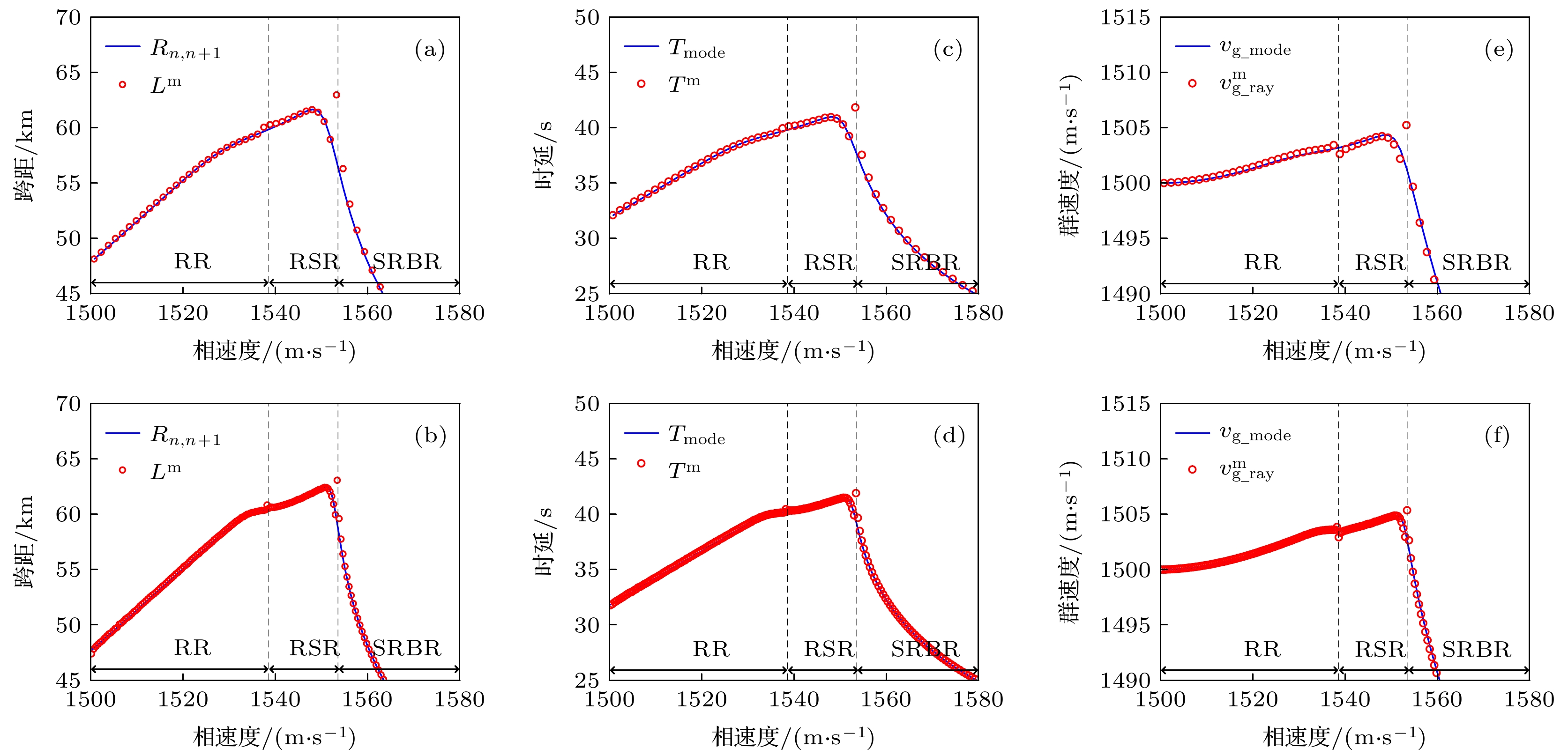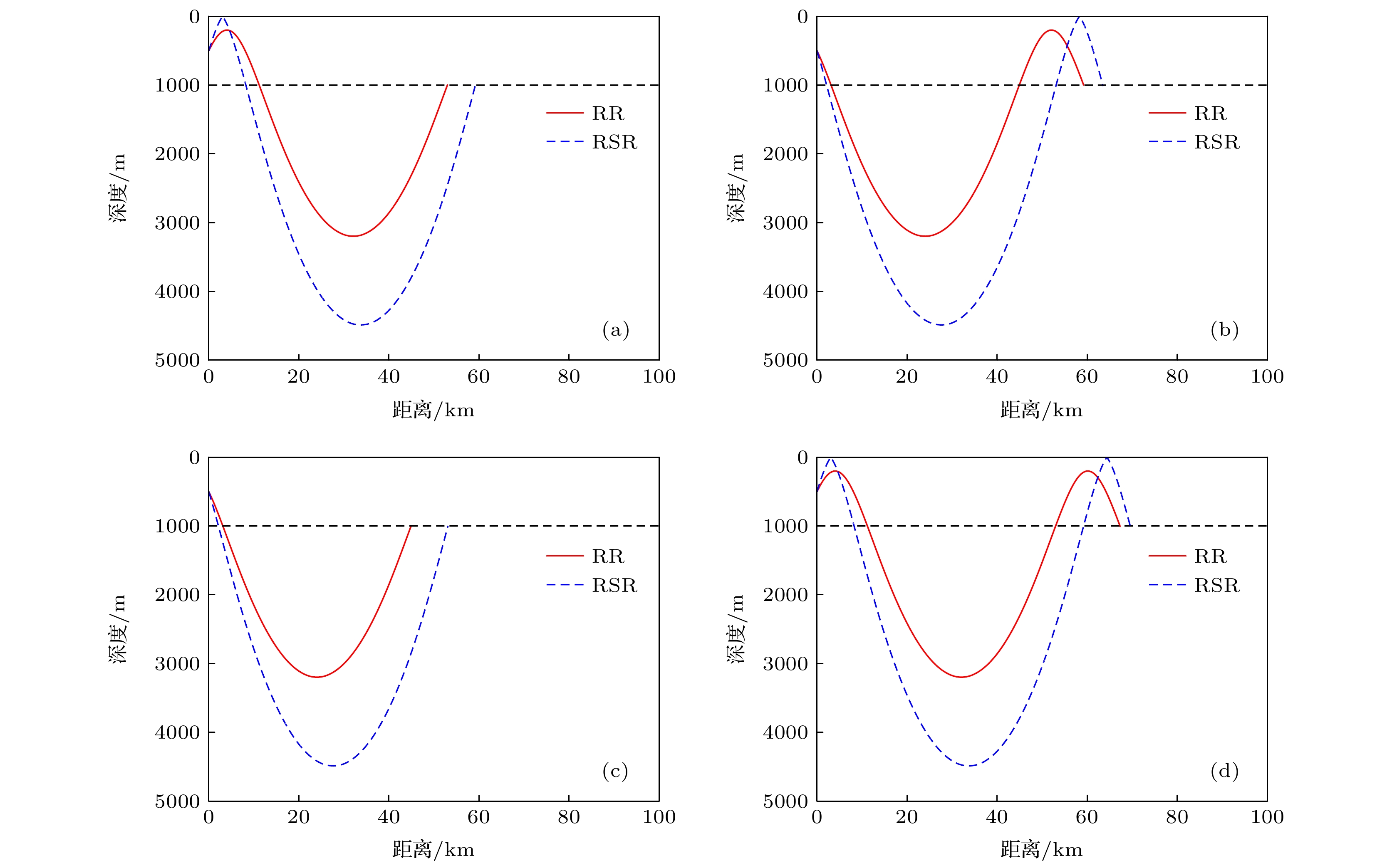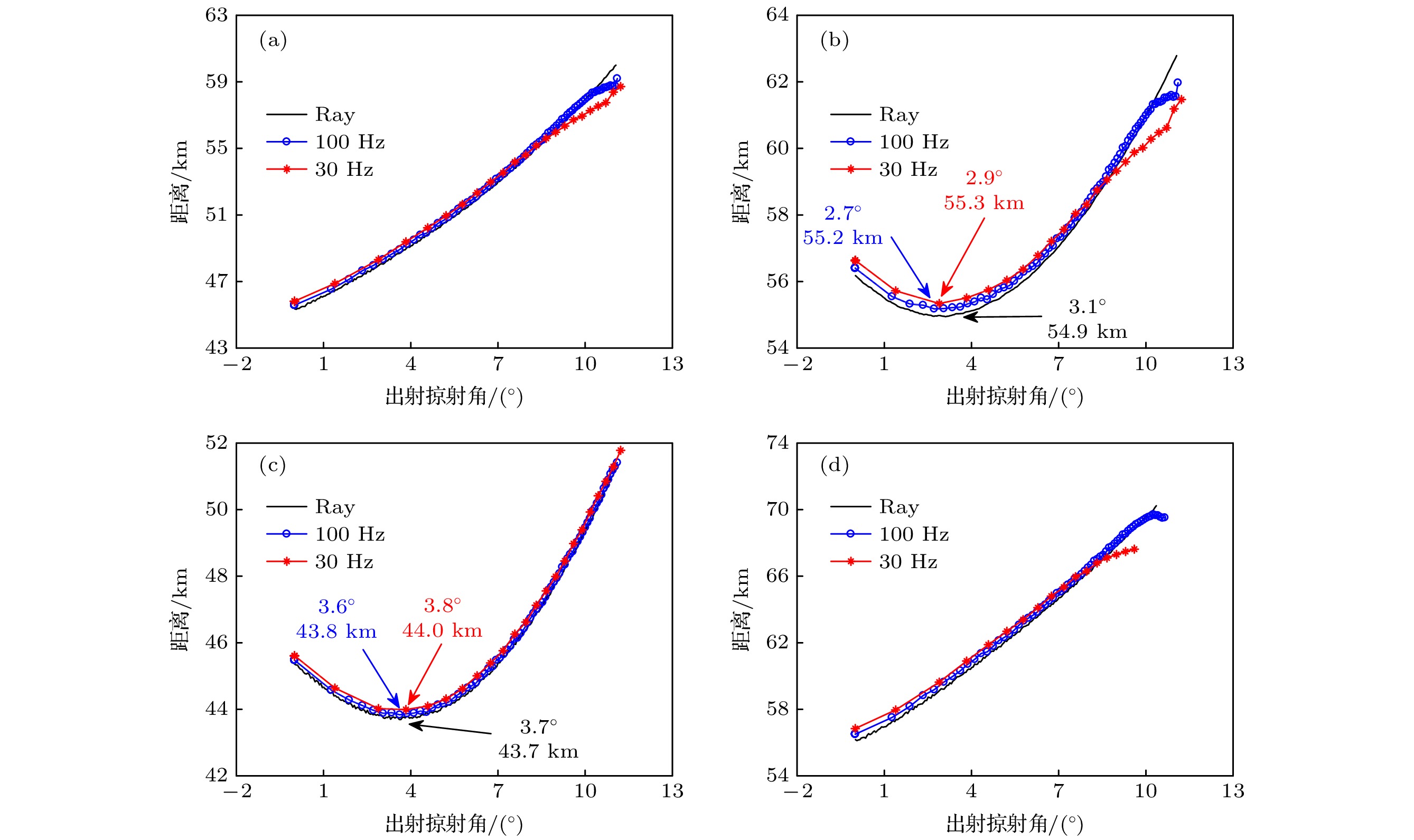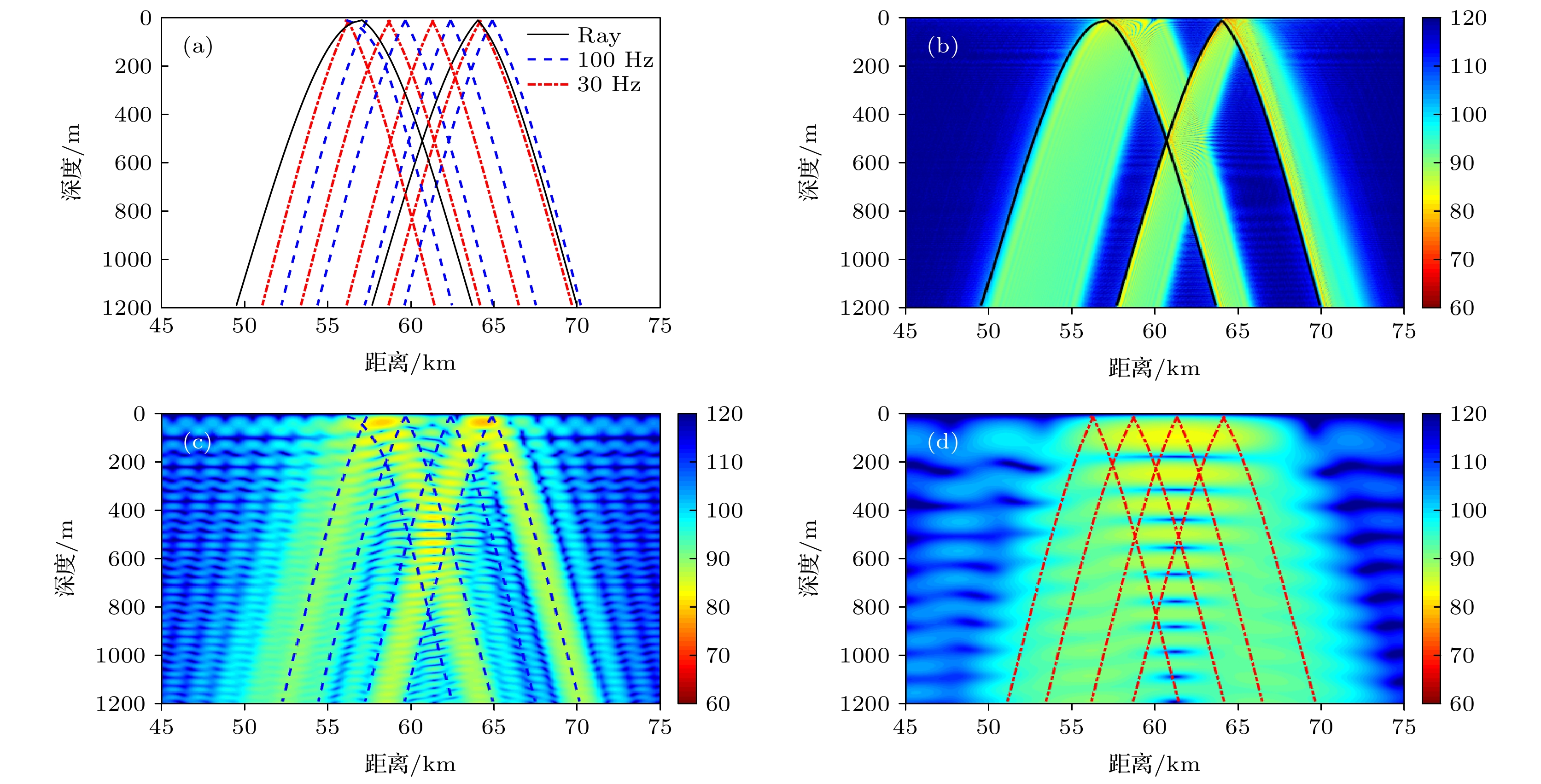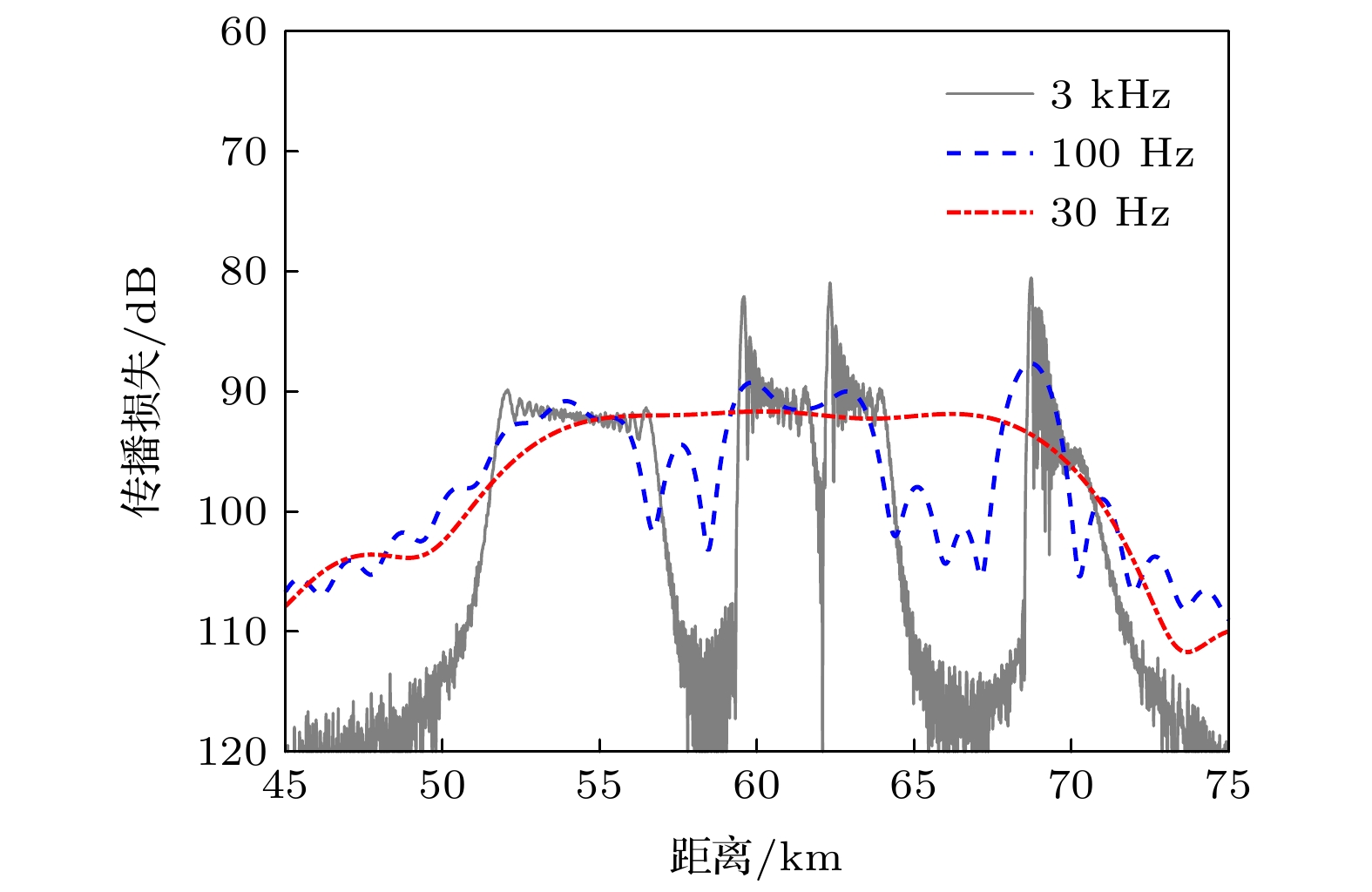-
本文从射线-简正波理论出发, 推导了计及衍射相移时声线跨距、传播时延与群速度的表达式, 在此基础上给出了一种包含衍射相移影响的深海会聚区焦散结构计算模型. 对典型深海声道中第一个上会聚区的仿真研究表明: 高频条件下纯折射(refracted-refracted, RR)型会聚区有3条焦散线, 海面反射(refracted surface-reflected, RSR)型会聚区有4条焦散线. 通过与高频结果对比, 低频条件下计及衍射相移后发现, 界面反射相移引起的水平位移使RR型焦散线向靠近声源的方向水平偏移, 使RSR型声线额外多产生数条焦散线, 而声波以非均匀波形式传播时产生的位移使RR型焦散线向远离声源的方向水平偏移. 频率升高后, 声衍射效应减小, 焦散结构趋于经典射线理论的计算结果. 本文给出的模型物理意义清晰, 计算简便准确, 弥补了经典射线理论在低频条件下适用性不强的缺陷.The constant phase shift
$- {{\text{π}}}/{2}$ generated by a turning point is an ideal approximation under high frequency conditions. In fact, when sound waves pass through a turning point, it will travel horizontally for a certain distance in the form of inhomogeneous plane wave and then be refracted back. At this time, a functional phase shift should also be included at the turning point. In addition, a refracted ray will bring about reflection phase shift when the turning point is close to the waveguide edge. These two kinds of phase shifts which are associated with the diffraction phenomenon are called diffraction phase shifts in this paper and are more notable when the frequency goes down. In order to accurately obtain the caustic structure at low frequency, the diffraction phase shift is used to correct the classical ray theory in calculating ray skip distance, traveling time, and group velocity in this work. On this basis, a simple and explicit analytical model is proposed which is suitable for calculating the low frequency deep water caustics. The numerical study of the first upper convergence zone in the complete deep water sound channel shows that there are three caustic lines in the refracted-refracted (RR) convergence zone and four caustic lines in the refracted surface-reflected (RSR) convergence zone under the condition of high frequency hypothesis. When the diffraction phase shifts at low frequency are included, and compares with high frequency results, it is found that the horizontal beam displacement caused by the reflection phase shift will make the RR caustics horizontally move towards the source and also lead the RSR rays to generate several new caustics, while the beam displacement caused by sound propagating in the form of inhomogeneous plan wave will make the RR caustics horizontally move away from the sound source. Accompanied with the increased frequency, the diffraction effect will decrease, and the caustic structure gradually tends to the classical ray theory results. The reliability of the correction results is verified by the normal mode theory. The model proposed in this work makes up for the deficiency of classical ray theory.[1] Munk W H 1974 J. Acoust. Soc. Am. 55 220
 Google Scholar
Google Scholar
[2] Hale F E 1961 J. Acoust. Soc. Am. 33 456
 Google Scholar
Google Scholar
[3] Brekhovskih L M 1980 Waves in Layered Media (2nd Ed.) (New York: Academic Press) p377
[4] Urick R J 1965 J. Acoust. Soc. Am. 38 348
 Google Scholar
Google Scholar
[5] 张仁和 1980 声学学报 1 28
 Google Scholar
Google Scholar
Zhang R H 1980 Acta Acust. 1 28
 Google Scholar
Google Scholar
[6] 张仁和 1982 声学学报 7 75
 Google Scholar
Google Scholar
Zhang R H 1982 Acta Acust. 7 75
 Google Scholar
Google Scholar
[7] 张仁和 1988 声学学报 13 101
 Google Scholar
Google Scholar
Zhang R H 1988 Acta Acust. 13 101
 Google Scholar
Google Scholar
[8] Bongiovanni K P, Siegmann W L 1996 J. Acoust. Soc. Am. 100 3033
 Google Scholar
Google Scholar
[9] 徐传秀 2017 博士学位论文 (哈尔滨: 哈尔滨工程大学)
Xu C X 2017 Ph. D. Dissertation (Harbin: Harbin Engineering University) (in Chinese)
[10] 朴胜春, 栗子洋, 王笑寒, 张明辉 2021 物理学报 70 024301
 Google Scholar
Google Scholar
Piao S C, Li Z Y, Wang X H, Zhang M H 2021 Acta Phys. Sin. 70 024301
 Google Scholar
Google Scholar
[11] 张青青, 李整林, 秦继兴, 李文, 吴双林 2020 声学学报 45 458
 Google Scholar
Google Scholar
Zhang Q Q, Li Z L, Qin J X, Li W, Wu S L 2020 Acta Acust. 45 458
 Google Scholar
Google Scholar
[12] 张鹏, 李整林, 吴立新, 张仁和, 秦继兴 2019 物理学报 68 014301
 Google Scholar
Google Scholar
Zhang P, Li Z L, Wu L X, Zhang R H, Qin J X 2019 Acta Phys. Sin. 68 014301
 Google Scholar
Google Scholar
[13] 杨帆, 王华, 高文典, 孟小嵩, 刘云龙 2021 海洋预报 38 103
 Google Scholar
Google Scholar
Yang F, Wang H, Gao W D, Meng X S, Liu Y L 2021 Marine Forecasts. 38 103
 Google Scholar
Google Scholar
[14] Henrick R F, Burkom H S 1983 J. Acoust. Soc. Am. 73 173
 Google Scholar
Google Scholar
[15] Lawrence M W 1983 J. Acoust. Soc. Am. 73 474
 Google Scholar
Google Scholar
[16] Baer R N 1981 J. Acoust. Soc. Am. 69 70
 Google Scholar
Google Scholar
[17] 毕思昭, 彭朝晖 2021 物理学报 70 114303
 Google Scholar
Google Scholar
Bi S Z, Peng Z H 2021 Acta Phys. Sin. 70 114303
 Google Scholar
Google Scholar
[18] Guthrie A N, Fitzgerald R M, Nutile D A, Shaffer J D 1974 J. Acoust. Soc. Am. 56 58
 Google Scholar
Google Scholar
[19] 张海刚, 马志康, 付金山, 朴胜春 2021 声学学报 46 1093
 Google Scholar
Google Scholar
Zhang H G, Ma Z K, Fu J S, Piao S C 2021 Acta Acust. 46 1093
 Google Scholar
Google Scholar
[20] Davis J A 1975 J. Acoust. Soc. Am. 57 276
 Google Scholar
Google Scholar
[21] Tindle C T, Guthrie K M 1974 J. Sound Vibration. 34 291
 Google Scholar
Google Scholar
[22] Guthrie K M 1974 J. Sound Vibration. 32 289
 Google Scholar
Google Scholar
[23] Gordon D F 1980 J. Acoust. Soc. Am. 67 106
 Google Scholar
Google Scholar
[24] Tindle C T, Weston D E 1980 J. Acoust. Soc. Am. 67 1614
 Google Scholar
Google Scholar
[25] Tindle C T, Bold G E J 1981 J. Acoust. Soc. Am. 70 813
 Google Scholar
Google Scholar
[26] 张仁和, 李风华 1999 中国科学 A辑 29 241
Zhang R H, Li F H 1999 Sci. China A 29 241 (in Chinese)
[27] Murphy E L, Davis J A 1974 J. Acoust. Soc. Am. 56 1747
 Google Scholar
Google Scholar
[28] Davis J A 1974 Modified Ray Theory for Discontinuous Media (Massachusetts: Woods Hole Institution) p18
[29] Jensen F B, Kuperman W A, Porter M B, Schmidt H 2011 Computational Ocean Acoustics (2nd Ed.) (NewYork: Springer-Verlag) pp86, 219, 340
[30] 张揽月, 张明辉 2016 振动与声基础 (哈尔滨: 哈尔滨工程大学出版社) 第95页
Zhang L Y, Zhang M H 2016 Foundation of Vibration and Sound (Harbin: Harbin Engineering University Press) p95 (in Chinese)
[31] Chapman D M F, Ellis D D 1983 J. Acoust. Soc. Am. 74 973
 Google Scholar
Google Scholar
[32] Ferla M C, Jensen F B, Kuperman W A 1982 J. Acoust. Soc. Am. 72 505
 Google Scholar
Google Scholar
[33] Tindle C T 2002 J. Acoust. Soc. Am. 112 464
 Google Scholar
Google Scholar
[34] White D W, Pedersen M A 1981 J. Acoust. Soc. Am. 69 1029
 Google Scholar
Google Scholar
[35] Grigorieva N S, Fridman G M, Mercer J A, et al. 2009 J. Acoust. Soc. Am. 125 1919
 Google Scholar
Google Scholar
-
图 3 不同频率下经典射线理论与简正波理论的计算结果以及经典射线理论的计算误差 (a) 声线跨距; (b) 距离误差; (c) 传播时延; (d) 传播时延误差; (e) 群速度; (f) 群速度误差
Fig. 3. Calculation results of classical ray theory and normal mode theory at different frequencies and the calculation errors of classical ray theory: (a) Ray skip distance; (b) distance error; (c) traveling time; (d) traveling time error; (e) group velocity; (f) group velocity error.
图 4 不同频率下声衍射对距离与时延的贡献 (a)
${\phi _a}$ 与${\phi _b}$ 对传播距离的贡献; (b)${\phi _a}$ 与${\phi _b}$ 对传播时延的贡献; (c)${\phi _{{\text{pr}}}}$ 与${\phi _{{\text{bot}}}}$ 对传播距离的贡献; (d)${\phi _{{\text{pr}}}}$ 与${\phi _{{\text{bot}}}}$ 对传播时延的贡献; (e)$\Delta r$ ; (f)$\Delta t$ Fig. 4. Contribution of sound diffraction to propagation distance and traveling time at different frequencies: (a) Contribution of
${\phi _a}$ and${\phi _b}$ to propagation distance; (b) contribution of${\phi _a}$ and${\phi _b}$ to traveling time; (c) contribution of${\phi _{{\text{pr}}}}$ and${\phi _{{\text{bot}}}}$ to propagation distance; (d) contribution of${\phi _{{\text{pr}}}}$ and${\phi _{{\text{bot}}}}$ to traveling time; (e)$\Delta r$ ; (f)$\Delta t$ .图 5 不同频率下利用衍射相移对声场参数的修正结果 (a) 30 Hz时的声线跨距; (b) 100 Hz时的声线跨距; (c) 30 Hz时的传播时延; (d) 100 Hz时的传播时延; (e) 30 Hz时的群速度; (f) 100 Hz时的群速度
Fig. 5. Correction results of sound field parameters by diffraction phase shift at different frequencies: (a) Ray skip distance at 30 Hz; (b) ray skip distance at 100 Hz; (c) traveling time at 30 Hz; (d) traveling time at 100 Hz; (e) group velocity at 30 Hz; (f) group velocity at 100 Hz.
表 1 不同频率下, 不同相速度区间内
${r_a}$ ,${r_b}$ ,${r_{{\text{pr}}}}$ ,${r_{{\text{bot}}}}$ 与$\Delta r$ 的取值符号Table 1. Values of
${r_a}$ ,${r_b}$ ,${r_{{\text{pr}}}}$ ,${r_{{\text{bot}}}}$ and$\Delta r$ in different phase velocity range at different frequencies.相速度区间/(m·s–1) ${r_a}$ ${r_b}$ ${r_{{\text{pr}}}}$ ${r_{{\text{bot}}}}$ $\Delta r$ 30 Hz 100 Hz 1500—1519 1500—1530 > 0 > 0 0 0 < 0 1519—1527 1530—1533 > 0 > 0 > 0 0 < 0 1527.0—1538.6 1533.0—1538.6 > 0 > 0 > 0 0 > 0 1538.6—1544.0 1538.6—1543.0 0 > 0 > 0 0 > 0 — 1543—1550 0 > 0 > 0 0 < 0 — 1550—1551 0 > 0 > 0 > 0 < 0 1544.0—1553.6 1551.0—1553.6 0 > 0 > 0 > 0 > 0 1553.6—1556.0 1553.6—1555.0 0 0 > 0 > 0 > 0 1556—1568 1555—1556 0 0 > 0 0 > 0 1568—1700 1556—1700 0 0 0 0 0 -
[1] Munk W H 1974 J. Acoust. Soc. Am. 55 220
 Google Scholar
Google Scholar
[2] Hale F E 1961 J. Acoust. Soc. Am. 33 456
 Google Scholar
Google Scholar
[3] Brekhovskih L M 1980 Waves in Layered Media (2nd Ed.) (New York: Academic Press) p377
[4] Urick R J 1965 J. Acoust. Soc. Am. 38 348
 Google Scholar
Google Scholar
[5] 张仁和 1980 声学学报 1 28
 Google Scholar
Google Scholar
Zhang R H 1980 Acta Acust. 1 28
 Google Scholar
Google Scholar
[6] 张仁和 1982 声学学报 7 75
 Google Scholar
Google Scholar
Zhang R H 1982 Acta Acust. 7 75
 Google Scholar
Google Scholar
[7] 张仁和 1988 声学学报 13 101
 Google Scholar
Google Scholar
Zhang R H 1988 Acta Acust. 13 101
 Google Scholar
Google Scholar
[8] Bongiovanni K P, Siegmann W L 1996 J. Acoust. Soc. Am. 100 3033
 Google Scholar
Google Scholar
[9] 徐传秀 2017 博士学位论文 (哈尔滨: 哈尔滨工程大学)
Xu C X 2017 Ph. D. Dissertation (Harbin: Harbin Engineering University) (in Chinese)
[10] 朴胜春, 栗子洋, 王笑寒, 张明辉 2021 物理学报 70 024301
 Google Scholar
Google Scholar
Piao S C, Li Z Y, Wang X H, Zhang M H 2021 Acta Phys. Sin. 70 024301
 Google Scholar
Google Scholar
[11] 张青青, 李整林, 秦继兴, 李文, 吴双林 2020 声学学报 45 458
 Google Scholar
Google Scholar
Zhang Q Q, Li Z L, Qin J X, Li W, Wu S L 2020 Acta Acust. 45 458
 Google Scholar
Google Scholar
[12] 张鹏, 李整林, 吴立新, 张仁和, 秦继兴 2019 物理学报 68 014301
 Google Scholar
Google Scholar
Zhang P, Li Z L, Wu L X, Zhang R H, Qin J X 2019 Acta Phys. Sin. 68 014301
 Google Scholar
Google Scholar
[13] 杨帆, 王华, 高文典, 孟小嵩, 刘云龙 2021 海洋预报 38 103
 Google Scholar
Google Scholar
Yang F, Wang H, Gao W D, Meng X S, Liu Y L 2021 Marine Forecasts. 38 103
 Google Scholar
Google Scholar
[14] Henrick R F, Burkom H S 1983 J. Acoust. Soc. Am. 73 173
 Google Scholar
Google Scholar
[15] Lawrence M W 1983 J. Acoust. Soc. Am. 73 474
 Google Scholar
Google Scholar
[16] Baer R N 1981 J. Acoust. Soc. Am. 69 70
 Google Scholar
Google Scholar
[17] 毕思昭, 彭朝晖 2021 物理学报 70 114303
 Google Scholar
Google Scholar
Bi S Z, Peng Z H 2021 Acta Phys. Sin. 70 114303
 Google Scholar
Google Scholar
[18] Guthrie A N, Fitzgerald R M, Nutile D A, Shaffer J D 1974 J. Acoust. Soc. Am. 56 58
 Google Scholar
Google Scholar
[19] 张海刚, 马志康, 付金山, 朴胜春 2021 声学学报 46 1093
 Google Scholar
Google Scholar
Zhang H G, Ma Z K, Fu J S, Piao S C 2021 Acta Acust. 46 1093
 Google Scholar
Google Scholar
[20] Davis J A 1975 J. Acoust. Soc. Am. 57 276
 Google Scholar
Google Scholar
[21] Tindle C T, Guthrie K M 1974 J. Sound Vibration. 34 291
 Google Scholar
Google Scholar
[22] Guthrie K M 1974 J. Sound Vibration. 32 289
 Google Scholar
Google Scholar
[23] Gordon D F 1980 J. Acoust. Soc. Am. 67 106
 Google Scholar
Google Scholar
[24] Tindle C T, Weston D E 1980 J. Acoust. Soc. Am. 67 1614
 Google Scholar
Google Scholar
[25] Tindle C T, Bold G E J 1981 J. Acoust. Soc. Am. 70 813
 Google Scholar
Google Scholar
[26] 张仁和, 李风华 1999 中国科学 A辑 29 241
Zhang R H, Li F H 1999 Sci. China A 29 241 (in Chinese)
[27] Murphy E L, Davis J A 1974 J. Acoust. Soc. Am. 56 1747
 Google Scholar
Google Scholar
[28] Davis J A 1974 Modified Ray Theory for Discontinuous Media (Massachusetts: Woods Hole Institution) p18
[29] Jensen F B, Kuperman W A, Porter M B, Schmidt H 2011 Computational Ocean Acoustics (2nd Ed.) (NewYork: Springer-Verlag) pp86, 219, 340
[30] 张揽月, 张明辉 2016 振动与声基础 (哈尔滨: 哈尔滨工程大学出版社) 第95页
Zhang L Y, Zhang M H 2016 Foundation of Vibration and Sound (Harbin: Harbin Engineering University Press) p95 (in Chinese)
[31] Chapman D M F, Ellis D D 1983 J. Acoust. Soc. Am. 74 973
 Google Scholar
Google Scholar
[32] Ferla M C, Jensen F B, Kuperman W A 1982 J. Acoust. Soc. Am. 72 505
 Google Scholar
Google Scholar
[33] Tindle C T 2002 J. Acoust. Soc. Am. 112 464
 Google Scholar
Google Scholar
[34] White D W, Pedersen M A 1981 J. Acoust. Soc. Am. 69 1029
 Google Scholar
Google Scholar
[35] Grigorieva N S, Fridman G M, Mercer J A, et al. 2009 J. Acoust. Soc. Am. 125 1919
 Google Scholar
Google Scholar
计量
- 文章访问数: 4930
- PDF下载量: 89
- 被引次数: 0















 下载:
下载:























